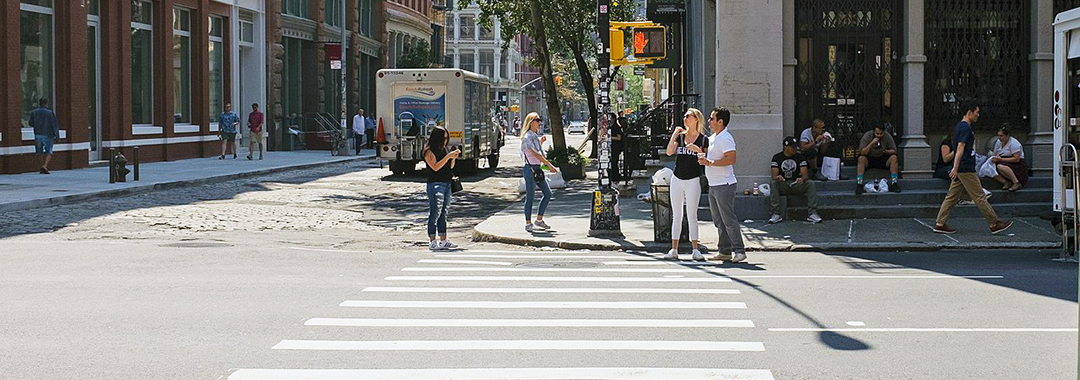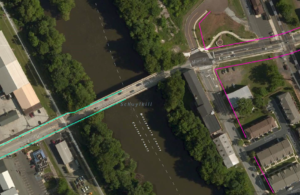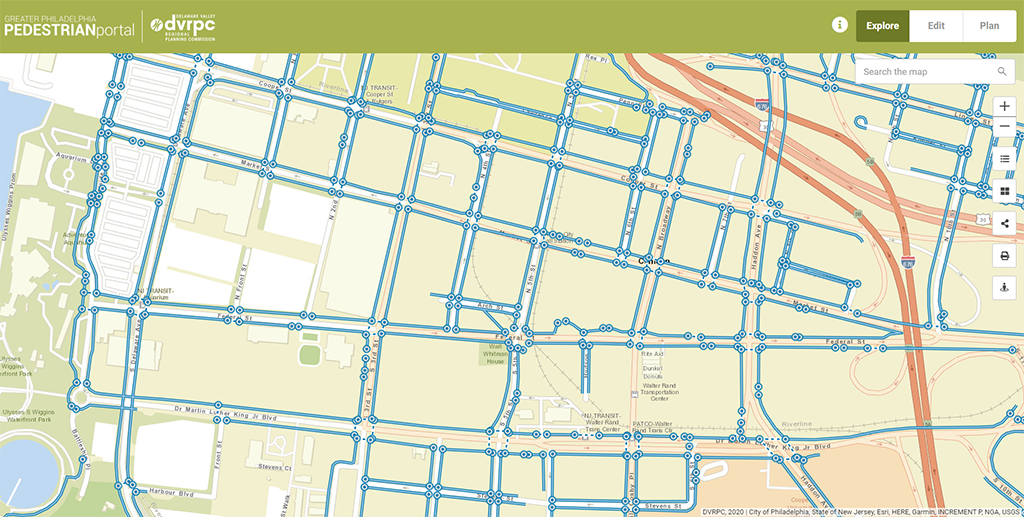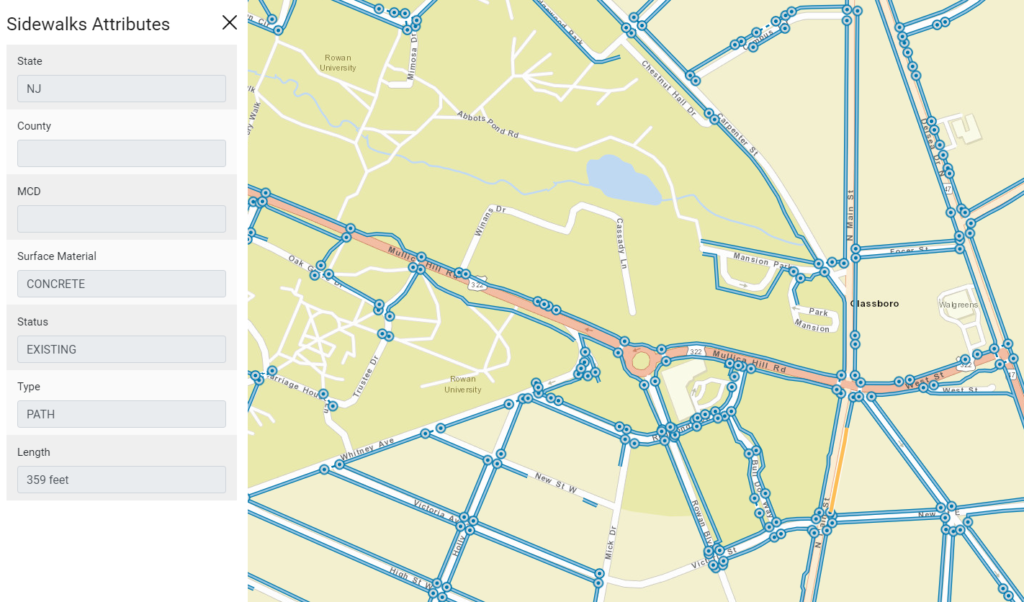Improved walkability and accessibility help to create vibrant and healthy communities. The Delaware Valley Regional Planning Commission (DVRPC), the metropolitan planning organization for Greater Philadelphia and Burlington, Camden and Gloucester Counties in New Jersey, is seeking to understand the region’s pedestrian infrastructure through the development of an online inventory, map, and platform for public participation and crowdsourcing. According to DVRPC, the goal of the project is, “to assist with planning efforts to help communities in the region become more pedestrian-friendly and accessible.”
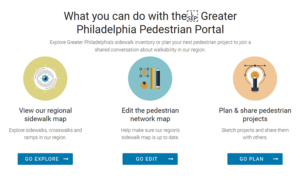
Options from the DVRPC Pedestrian Portal homepage
DVRPC hopes that these new tools will assist the agency and its partners to more efficiently identify and prioritize walkability improvements across the region. The online platform is expected to improve asset management and support various regional planning and place-specific initiatives such as Safe Routes to School, pedestrian safety audits, plans for healthy communities, and strategies for providing safe and equitable access to public transportation.
The need for better sidewalk data was suggested by DVRPC staff during a data roundtable meeting and became the impetus for the Sidewalk Inventory Project, according to DVRPC’s Kim Korejko. The MPO had already conducted work on bicycle infrastructure in the region, but lacked data on pedestrian infrastructure. The absence of a good inventory of sidewalk data was also felt by agency staff who had previously worked on transit station area walkability studies. To address this gap, DVRPC resolved to assemble a seamless and standardized GIS dataset of sidewalks in the region.
DVRPC sought state funding from both Pennsylvania and New Jersey to start the project in 2018. The planned platform for crowdsourcing and community involvement was well-aligned with “PennDOT Connects,” a Pennsylvania Department of Transportation initiative that supports collaboration with communities to sustain and expand mobility in the state. This alignment was a principal reason that the project received funding from Pennsylvania. The crowdsourcing platform also aligns well with the Federal Highway Administration EDC-5 initiative to advance crowdsourcing for operations.
Chester and Montgomery Counties in Pennsylvania had previously developed sidewalk databases, but the counties did not follow a standardized methodology for data visualization. As a result, DVRPC needed to rework the data for integration into the new dataset. Philadelphia County was also assembling sidewalk data at the time, but differences in data methodology along with the county’s scale have led to delays in assembling and publishing their inventory.
The DVRPC sidewalk inventory is not the first of its kind in the country. TriMet, Portland, Oregon’s transit operator, undertook a pedestrian network analysis in 2011 with the goal of improving pedestrian access to transit stops, especially in the suburbs surrounding the city. Once compiled, TriMet was able to put forth 10 pedestrian access projects to improve pedestrian access to transit stops, the majority of which were bus stops, but also to light rail and commuter rail stations. TriMet is continuing its pedestrian network analysis, and is seeking public comment on transit stops with low pedestrian accessibility. DVRPC also cited Denver and Seattle’s sidewalk inventories as inspiration for the Philadelphia project.
The TriMet Pedestrian Network Analysis can be found here.
DVRPC staff were surveyed prior to the assembly of the database to explore how they would use the tool and what features they would want:
- Sidewalk mileage and gaps — 60 percent said they would use the database to calculate sidewalk mileage and gaps to set goals and measure progress for improved network walkability.
- Pedestrian routing and modeling — 57 percent sought to use the database for pedestrian network routing and modeling
- Visualization — 51 percent would use it to help visualize the sidewalk data.
In terms of the data features captured by the inventory and mapping, 83 percent of staff said that they wanted to know sidewalk presence, 70 percent wanted to know the sidewalk conditions, and 59 percent wanted to know of the presence of curb ramps.
Out of 30 responses, 29 staff members stated that they wanted to know the presence of crosswalks, 24 wanted to see what pedestrian signalization types are present at intersections, and 15 wanted to know the characteristics of crosswalks in the network.
DVRPC has published a sidewalk inventory, including curb ramps and crosswalks for Bucks, Chester, Delaware, and Montgomery Counties on the Pennsylvania side of their region. A sidewalk inventory for the New Jersey portion of the region was added in February 2020. Release of the Philadelphia County inventory is expected in fall 2020.
To leverage its limited capacity to maintain the database, DVRPC is seeking to crowdsource sidewalk conditions by engaging the public to help keep the map up-to-date and accurate. Community members will be able to create an account to access the editing platform to add new infrastructure and attributes to the database.
In addition, DVRPC hopes to identify and maintain a list of potential pedestrian facility projects through its Pedestrian Facilities and Planning Portal. The portal will provide a space for collaboration between local and regional planning partners working on pedestrian improvements. The secure online interface will (1) provide access to and accommodate maintenance of the regional sidewalk inventory by local entities and (2) allow local and regional planning partners to share their pedestrian facility priorities (such as those identified in their comprehensive/ master plans or those for which they seek grant funding) on an interactive map.
While the planning and editing portals are not yet active, the sidewalk, crosswalk, and curb ramp shapefiles can be downloaded through the DVRPC GIS portal for those wishing to use the inventory for analysis. Once the data has been fully assembled, DVRPC plans to undertake further analyses of pedestrian access to transit and bus stations.
The Greater Philadelphia Pedestrian Portal, which includes the currently available New Jersey and Pennsylvania inventories, can be found here.
Resources:
City of Seattle. “Access Map, Walkability.” https://www.accessmap.io/.
Delaware Valley Regional Planning Commission. “The Greater Philadelphia Pedestrian Portal.” https://walk.dvrpc.org/.
Korejko, Kim. March 2018. DVRPC’s Sidewalk Inventory Project. Presentation. https://www.dvrpc.org/Walk/pdf/DVRPCSidewalkInventory_websiteMar2018.pdf.
Pennsylvania Department of Transportation. “PennDOT Connects.” https://www.penndot.gov/ProjectAndPrograms/Planning/Pages/PennDOT-Connects.aspx.
TriMet. “Improving Pedestrian Access to Transit.” https://trimet.org/walk/.
Walk Denver. June 2016. “Congratulations to the WALKscope Data Challenge Winners!” http://www.walkdenver.org/congratulations-to-the-walkscope-data-challenge-winners/

